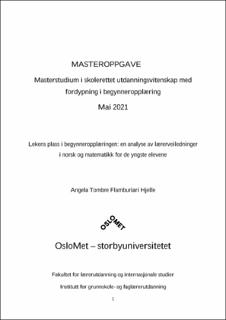| dc.contributor.advisor | Nilssen, Jannike Hegdal | |
| dc.contributor.advisor | Becher, Aslaug Andreassen | |
| dc.contributor.author | Hjelle, Angela Tombre Flamburiari | |
| dc.date.accessioned | 2021-10-14T06:16:00Z | |
| dc.date.available | 2021-10-14T06:16:00Z | |
| dc.date.issued | 2021 | |
| dc.identifier.uri | https://hdl.handle.net/11250/2799920 | |
| dc.description.abstract | Gjennom en kvalitativ, teoridrevet innholdsanalyse har jeg forsøkt å svare på problemstillingen: På hvilke måter tilrettelegger lærerveiledningene for lekpregete aktiviteter i norsk og matematikk for de yngste elevene? Forskningsspørsmålene er designet for å hjelpe meg å besvare problemstillingen, og skape en tråd gjennom oppgaven. Disse forskningsspørsmålene er 1) hva kjennetegner lekpregete aktiviteter i lærerveiledningene? 2) Hvilke lekpregete aktiviteter tilrettelegges bare gjennom lærerveiledningene, og hvilke finnes i elevenes lærebok? 3) På hvilke læringsarenaer foregår de lekpregete aktivitetene? 4) Hvilke ulikheter finnes i aktivitetene mellom fagene norsk og matematikk? Datamaterialet som innholdsanalysen er utført på, er Salto 1A, læreren bok, som representerer norskfaget, og Volum 1A, lærerveiledning, for matematikkfaget. Det ble gjort fire hovedfunn gjennom analysen, alle relatert til forskningsspørsmålene: Det første hovedfunnet dreier seg om lærerveiledningenes ulike funksjoner. Salto 1A, lærerens bok inneholdt detaljerte veiledninger for undervisningsøktene, og inneholdt i tillegg egne sider med forslag til leker som kunne brukes. Gjennom dette øker lærerens generelle lekerepertoar, da lekene lett kan overføres til andre temaer og fag. Den andre lærerveiledningen, Volum 1A, var konsentrert rundt detaljerte opplegg rundt undervisningsøktene, med veiledning rundt oppstart av time, arbeid med oppgavene, og avslutning av timen. Det andre hovedfunnet dreier seg om norskverkets variasjon av tilrettelagte aktiviteter. Variasjonen er tydeligst gjennom aktivitetene som kun foreslås gjennom lærerveiledningenes sider. Sidene fra elevenes lærebok inneholdt ikke den samme variasjonen. Det tredje hovedfunnet dreier seg om at matematikkverket viser tydelige tendenser i forhold til kategoriene helklassesamtaler, modellering og stillesittende arbeidsmetoder. Dette læreverket konsentrerer seg utelukkende om å veilede undervisningsøktene. Det fjerde hovedfunnet dreier seg om læringsarenaenes betydning for de lekpregete aktivitetene. Der finner jeg tydelige tendenser til at kategoriene felles lek og samarbeid sterkest tilrettelegges gjennom aktivitetene som foregår utendørs. Videre er kategoriene felles samtale og modellering fra lærer, oftere til stede i aktivitetene som foregår ved pulten. | en_US |
| dc.description.abstract | Through a qualitative, theory-driven content analysis, I have tried to answer the following topic question:
In what ways do the teacher guides facilitate playful activities in Norwegian and mathematics for the youngest students? The research questions are designed to help me answer the topic question. These research questions are 1) what characterizes playful activities in the teacher guides? 2) Which playful activities are arranged only through the teacher's guides, and which are found in the students' textbook? 3) In which learning arenas do the playful activities take place? 4) What differences are there in the activities between the subjects Norwegian and mathematics? The data material on which the content analysis is performed is Salto 1A, the teacher's book, which represents the Norwegian subject, and Volume 1A, the teacher's guide, for the mathematics subject. Four main findings were made through the analysis, all related to the research questions: The first main finding concerns the various functions of the teacher guides. Salto 1A, the teacher's book, contained detailed instructions for the teaching sessions, in addition to separate pages with suggestions for educational games. Through this, the teacher's general play repertoire increases, as the games can easily be transferred to other themes and subjects. The second teacher's guide, Volume 1A, was concentrated on detailed plans for the teaching sessions, with guidance on starting the class, working on the assignments, and ending the class. The second main finding concerns the variation of adapted activities through the teacher guide, Salto 1A. The variation is most evident through the activities that are only suggested through the pages of the teacher guides. The pages from the students' textbook did not contain the same variation. The third main finding is that the mathematics work shows clear tendencies in relation to the categories whole-class conversations, and modeling as social interaction. This teaching material concentrates exclusively on supervising the teaching sessions. The fourth main finding is about the importance of learning arenas for the playful activities. There I find clear tendencies that the categories of joint play and cooperation are most strongly facilitated through the activities that take place outdoors. Furthermore, the categories of joint conversation and modeling from the teacher are more often present in the activities that take place at the desk. | en_US |
| dc.language.iso | nob | en_US |
| dc.publisher | OsloMet - Storbyuniversitetet | en_US |
| dc.subject | Lærerveiledningsanalyser | en_US |
| dc.subject | Begynneropplæring | en_US |
| dc.subject | Lekpregete læringsaktiviteter | en_US |
| dc.subject | Lek | en_US |
| dc.subject | Læring | en_US |
| dc.title | Lekens plass i begynneropplæringen: en analyse av lærerveiledninger i norsk og matematikk for de yngste elevene | en_US |
| dc.title.alternative | Playful learning for the youngest students: an analysis of teacher guides in the subjects Norwegian and mathematics | en_US |
| dc.type | Master thesis | en_US |
| dc.description.version | publishedVersion | en_US |
| dc.source.pagenumber | 116 | en_US |
| dc.subject.nsi | VDP::Samfunnsvitenskap: 200::Pedagogiske fag: 280::Fagdidaktikk: 283 | en_US |
| dc.subject.nsi | VDP::Samfunnsvitenskap: 200::Pedagogiske fag: 280::Andre pedagogiske fag: 289 | en_US |
